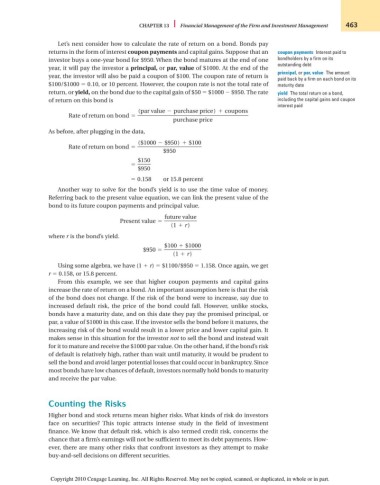Page 489 - Introduction to Business
P. 489
CHAPTER 13 Financial Management of the Firm and Investment Management 463
Let’s next consider how to calculate the rate of return on a bond. Bonds pay
returns in the form of interest coupon payments and capital gains. Suppose that an coupon payments Interest paid to
investor buys a one-year bond for $950. When the bond matures at the end of one bondholders by a firm on its
outstanding debt
year, it will pay the investor a principal, or par, value of $1000. At the end of the
principal, or par, value The amount
year, the investor will also be paid a coupon of $100. The coupon rate of return is
paid back by a firm on each bond on its
$100/$1000 0.10, or 10 percent. However, the coupon rate is not the total rate of maturity date
return, or yield, on the bond due to the capital gain of $50 $1000 $950. The rate yield The total return on a bond,
of return on this bond is including the capital gains and coupon
interest paid
(par value purchase price) coupons
Rate of return on bond
purchase price
As before, after plugging in the data,
($1000 $950) $100
Rate of return on bond
$950
$150
$950
0.158 or 15.8 percent
Another way to solve for the bond’s yield is to use the time value of money.
Referring back to the present value equation, we can link the present value of the
bond to its future coupon payments and principal value.
future value
Present value
(1 r)
where r is the bond’s yield.
$100 $1000
$950
(1 r)
Using some algebra, we have (1 r) $1100/$950 1.158. Once again, we get
r 0.158, or 15.8 percent.
From this example, we see that higher coupon payments and capital gains
increase the rate of return on a bond. An important assumption here is that the risk
of the bond does not change. If the risk of the bond were to increase, say due to
increased default risk, the price of the bond could fall. However, unlike stocks,
bonds have a maturity date, and on this date they pay the promised principal, or
par, a value of $1000 in this case. If the investor sells the bond before it matures, the
increasing risk of the bond would result in a lower price and lower capital gain. It
makes sense in this situation for the investor not to sell the bond and instead wait
for it to mature and receive the $1000 par value. On the other hand, if the bond’s risk
of default is relatively high, rather than wait until maturity, it would be prudent to
sell the bond and avoid larger potential losses that could occur in bankruptcy. Since
most bonds have low chances of default, investors normally hold bonds to maturity
and receive the par value.
Counting the Risks
Higher bond and stock returns mean higher risks. What kinds of risk do investors
face on securities? This topic attracts intense study in the field of investment
finance. We know that default risk, which is also termed credit risk, concerns the
chance that a firm’s earnings will not be sufficient to meet its debt payments. How-
ever, there are many other risks that confront investors as they attempt to make
buy-and-sell decisions on different securities.
Copyright 2010 Cengage Learning, Inc. All Rights Reserved. May not be copied, scanned, or duplicated, in whole or in part.

